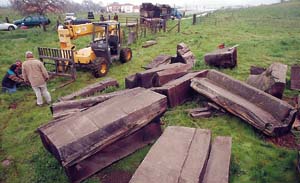Jan Petersen and J. Freiermuth have just about every museum and
eBay junkie out there beat, hands-down. Their prized possession was
already an antique when Jesus was born, it was once one of the
largest living things on earth, and it can’t be found anywhere
else. Which explains why the duo’s gigantia dendrum sequoia is such
a hot commodity.
Hollister – Jan Petersen and J. Freiermuth have just about every museum and eBay junkie out there beat, hands-down. Their prized possession was already an antique when Jesus was born, it was once one of the largest living things on earth, and it can’t be found anywhere else. Which explains why the duo’s gigantia dendrum sequoia is such a hot commodity.
“Right now I have a standing offer from a man in Japan to buy the whole tree, and he wants to give us a reasonably fair price for it,” said Petersen, a 53-year-old train conductor for Amtrak. “But he just wants to possess it so he’ll be the only one on the earth who has it.”
That’s the kind of collector Petersen and Freiermuth don’t want to see the timber from their 2,700-year-old giant sequoia go to. The tree has a personality, an aura, and can bounce karma back at unworthy buyers like a mirror, Petersen said.
“This tree has a special energy to it. It eliminates the people that want to do the wrong things with it. People have actually made offers, but before they could buy it their finances fell through,” he said.
Unworthy potential buyers include those like the man in Japan who just want to own a piece of the ancient tree as a claim to fame, or those who want to use it for lumber, Petersen said.
“What we have tried to do is sell it to people who will make something that will last and will be handed down to generations. We have sold it to people to make fine dining room tables; we have people that are world-renowned artists that use this wood, and then there are people who are just backyard sculptors that want to make something for their house. Even if they just want to have a block of the wood in their house, that’s OK, as long as it gets passed down. It is very important to us what people have for their designs,” Petersen said. “Since it was from 700 B.C., it would be ludicrous for us to sell it off for lumber.”
There isn’t anything so formal as an interview process for anyone who wants to buy pieces of the wood, Petersen said, but he always asks what they intend to do with it. And he’s turned people away if their plans weren’t up-to-snuff. After all, this tree has been with him for 30 years.
Petersen and Freiermuth’s giant sequoia journey began in 1975, 11 years after a snowstorm had knocked down the 328-foot tall tree in the Whittaker forest near the University of California at Berkeley. Since the university owned the forest land, it was legally allowed to put the tree up for public auction.
Freiermuth, a sculptor, heard of the auction from a friend who had worked with giant sequoia wood before. His friend lauded the wood’s softness and wrapping grain, which makes it perfect for chip-carving. But chances to get one’s hands on this unique timber don’t come around too often: Petersen believes he and Freiermuth now own the only giant sequoia in existence that isn’t growing in a forest somewhere. The trees only grew from Yosemite in the north to Porterville in the south (an area about 250 miles long and 50 miles wide, Petersen said), and they have been protected from harvesting by law for over 100 years.
To take on this once-in-a-lifetime venture, Freiermuth recruited his friend Petersen, who had started his own wood-chopping business by the age of 14 and “knew his way around a chain-saw.”
The pair’s bid was chosen out of 100 different offers, the closest one coming in at $5,200 more than their own.
“We bid against all types of big high-end lumber companies. But we had to tell the method of logging, and all of the other companies wanted to knock out 400 fir trees (around the sequoia) to chop it and haul it out. Our plan was not to touch anything within 20 feet of it. So that’s how we got it,” Petersen explained.
The two men purchased the sequoia in 1975, one month before snow began to fall on the tree, which lay on the ground at an elevation of about 6,500 feet. Once the snow melted, they would have about six months to work.
“The first six months we did the Michaelangelo thing where you look at it and think about what you’re going to do,” Petersen said. “We realized what a mammoth undertaking this really was.”
But once the winter gave way to spring, Petersen and Freiermuth went to work. They pitched a tent at 10,000 feet in Whittaker forest and worked from first light until after sun-down, every day, for the next six months. They chopped the colossal tree into blocks small enough to manage and transport: 4-feet-by-4-feet by 10 feet. Because the wood was still wet from the wintertime, each block weighed about 10,000 lbs.
Using an old navy cable bolted to a 200-ton boulder and one old truck for hauling, the pair managed over two grueling seasons to transport the entire tree – 228 feet tall, 27 feet in diameter and 82 feet in circumference – to Freiermuth’s parents’ house in San Benito County.
“We had to do a lot of caveman engineering,” Petersen laughed.
The Freiermuths owned 27 acres of land in the county, so they weren’t inconvenienced by the giant tree lying in pieces in their backyard, Petersen said. But when the couple passed away recently, Petersen and Freiermuth were forced to find a new storage place for their rather large – and rather old – baby. Using four double semi-trucks, the two men managed to once again move the tree pieces to a new location in early February – which they’re keeping a secret for fear of thieves stealing the valuable wood.
After 30 years, Petersen and Freiermuth still have approximately 40,000 board feet left, or about 40 percent of the original 100,000 board feet, Petersen said. And they’re looking to sell pieces of it off to anyone with good intentions.
“This wood will not go for less than $10 a board foot, unmilled,” Petersen said, adding regular clear-heart redwood that is milled goes for around $6 a board foot.
All things considered, the price doesn’t seem that outrageous. And, besides, it’s an antique.
“I’m 53. That’s not old if you’re a tree,” Petersen said. “Since I have a tree that’s 2,700 years old, I feel like an infant.”
Anyone interested in purchasing a piece of the tree can find contact infor-mation for Petersen at wi****@my*****.com, or call him at 866-655-6350.
Jessica Quandt covers politics for the Free Lance. Reach her at 831-637-5566 ext. 330 or at jq*****@fr***********.com.









